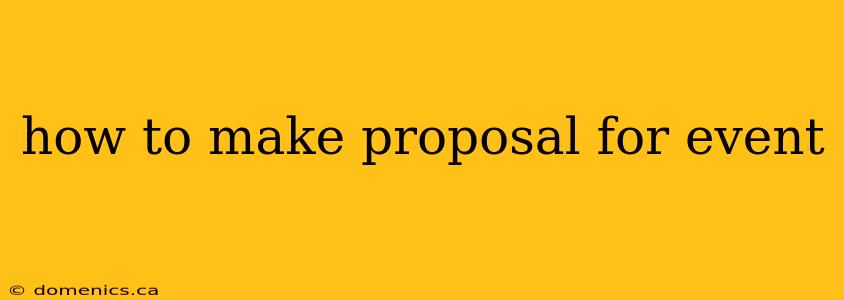Creating a compelling event proposal is crucial for securing your next event. This comprehensive guide will walk you through each step, from initial research to final delivery, ensuring your proposal stands out from the competition. Whether you're planning a conference, a corporate retreat, a wedding, or a community festival, this advice applies.
I. Understanding Your Audience and Defining Objectives
Before writing a single word, you need a solid foundation. This involves deeply understanding the client's needs and defining clear objectives.
1. Research & Client Needs
- Thorough Research: Begin with thorough research. Understand the client's business, their past events, and their target audience. What are their goals for this event? What kind of atmosphere are they hoping to create? What's their budget?
- Client Communication: Direct communication is key. Schedule a meeting or call to discuss their expectations in detail. Ask open-ended questions to uncover their unspoken needs. This initial contact helps shape your proposal.
2. Defining Clear Objectives
- Measurable Goals: Clearly define the event's objectives. These should be specific, measurable, achievable, relevant, and time-bound (SMART). For example, instead of "increase brand awareness," aim for "increase brand awareness by 20% as measured by social media engagement."
- Key Performance Indicators (KPIs): Identify the KPIs you’ll use to track success. This might include attendance numbers, social media reach, lead generation, or customer satisfaction surveys.
II. Structuring Your Event Proposal
A well-structured proposal is easy to read and understand. This section outlines the essential components.
3. Executive Summary
Start with a concise executive summary (one page max) that highlights the key aspects of your proposal. Include the event's purpose, your proposed approach, and the anticipated outcomes.
4. Introduction & Event Overview
- Event Description: Provide a clear and concise description of the event, including its purpose, target audience, and overall theme.
- Date, Time, & Location: Specify the date, time, and location (if already decided). If not, propose several suitable options with justifications.
5. Proposed Program/Agenda
- Detailed Schedule: Outline a detailed program or agenda, including specific activities, speakers (if applicable), and estimated timings. Visual aids, like a timeline, can significantly improve clarity.
- Activity Descriptions: Explain each activity in detail, highlighting its value and relevance to the event’s objectives.
6. Budget & Financial Projections
- Detailed Breakdown: Provide a clear and detailed breakdown of all anticipated costs. Include venue rental, catering, marketing, entertainment, staffing, and any other expenses. Justify significant expenses.
- Payment Schedule: Outline a realistic payment schedule, including milestones and deadlines.
7. Marketing & Promotion Strategy
Describe your plan for marketing and promoting the event. Include details on your target audience, the channels you will use (social media, email marketing, etc.), and any relevant metrics.
8. Logistics & Contingency Planning
Address logistical aspects like venue selection, AV equipment, catering, transportation, and security. Include contingency plans to address potential issues or delays.
9. Team & Expertise
Showcase the experience and expertise of your team. Highlight relevant past projects and client testimonials. This builds trust and credibility.
III. Polishing Your Proposal
The final stages are just as crucial as the planning.
10. Design & Presentation
- Professional Appearance: Ensure your proposal has a professional and visually appealing design. Use high-quality images and graphics. Maintain consistent branding.
- Easy Navigation: Make it easy for the client to navigate the document. Use clear headings, subheadings, bullet points, and white space.
11. Proofreading & Editing
Thoroughly proofread and edit your proposal before submitting it. Typos and grammatical errors can significantly impact your credibility. Have a fresh pair of eyes review it.
12. Delivery & Follow-Up
Deliver the proposal on time and in the agreed-upon format. Follow up with the client within a reasonable timeframe to discuss their feedback and answer any questions.
Conclusion
Creating a winning event proposal takes careful planning and execution. By following these steps, you’ll increase your chances of securing your next event and showcasing your event planning expertise. Remember, a successful proposal is not just about outlining the event, it’s about building a strong relationship with the client and demonstrating your commitment to their success.
